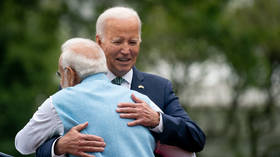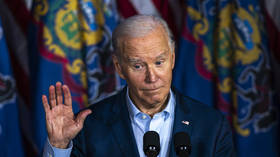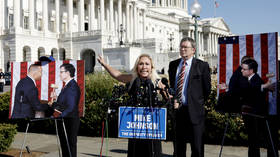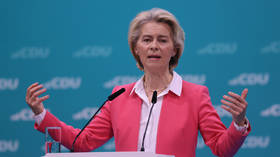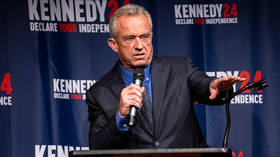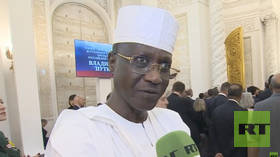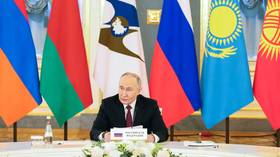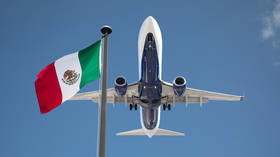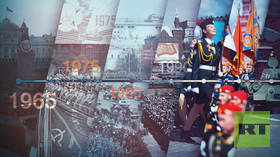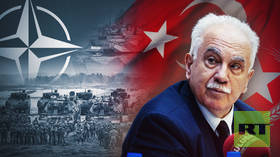Modi’s yoga charm offensive is an ode to India’s soft power
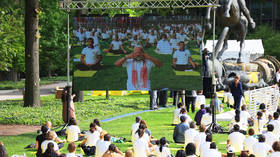
Even before Indian Prime Minister Narendra Modi took office in 2014, he made an impassioned plea to the New York-headquartered UN General Assembly (UNGA) to declare June 21 International Day of Yoga, a motion that was eventually adopted without a vote.
Modi, who belongs to the right-wing Bharatiya Janata Party (BJP), which is seen to champion the cause of the country’s majority Hindus, was thinking of tapping yoga to promote India’s soft power – the global manifestations of which up to now have been largely limited to Bollywood – long before he got an opportunity to lead the country.
What is yoga?
The word yoga traces its origin from the Sanskrit word ‘yuj’, which loosely translates to ‘unite’ in English. Yoga conveys a sense of union – the linking or joining of the individual self with the higher self.
According to some archeological finds, yoga-like practices of meditation may have existed as early as the India Valley Civilization (circa 3500-1500 BCE) in the northwestern regions of South Asia. The theory and practices of yoga were codified in the Yoga Sutras compiled by the Hindu author, mystic, and philosopher, Patanjali. These texts are dated by various scholars from the first to the fourth century CE.
Thousands of years later, and with the practice having spread globally, modern yoga is vastly different from the way people practiced it in ancient times.
Modern-day yoga started when it made its way into the Western world. The year 1893 is seen as the start of this period, when a Hindu monk named Swami Vivekananda lectured about yoga at the Parliament of Religions in Chicago. Later, hatha yoga, a branch of yoga that focuses on physical techniques, gained global traction, and eventually became what Westerners generally mean when they say ‘yoga’ today – a system of physical exercises.
Yoga hit the mainstream in the West after Indra Devi’s Hollywood yoga studio in 1947 started training celebrities. Devi, born to a Russian noblewoman and a Swedish banker in Riga, Latvia, was an early disciple of the ‘father of modern yoga’, Tirumalai Krishnamacharya, and is credited with popularizing yoga far and wide until her death in Buenos Aires, Argentina, at the age of 102 in 2002.
Modi’s yoga push
The Indian prime minister’s ascetic upbringing in the austere Hindu way as practiced by the Rashtriya Swayamsevak Sangh – the ideological parent of the BJP – made him an avid yoga practitioner, and his immense social media outreach helped him unleash the power of yoga on a global stage. He has a whopping 89.4 million followers on Twitter, putting him among the top tenmost-followed people in the world.
Modi has relentlessly propagated yoga during his foreign trips – especially in the West – to talk up the mysticism of India’s cultural export. He cited how yoga is about “harmony between man and nature; a holistic approach to health and wellbeing. It is not about exercise but to discover the sense of oneness with yourself, the world and nature.”
Yoga is at the heart of a sustainable way of life as well, Modi believes. “By changing our lifestyle and creating consciousness,” he suggested, yoga “can help us deal with climate change,” he said.
The politician in him has come to the fore as he harnessed the ancient practice to bond with his global counterparts, spread yoga as a tool of India’s soft power in the over 180 countries that have marked International Day of Yoga since its adoption in 2015, and boost the country’s foreign policy outreach and stature, which currently stands at once-unimaginable levels.
Shades of gimmickry?
While Modi’s enthusiastic use of yoga has won him the hearts and minds of foreign dignitaries, it has also created a flutter among his domestic constituency. The tactics, at times, have bordered on gimmickry, according to his critics, who often accuse him of playing to the gallery.
In the pre-Covid-19 pandemic era, each year’s International Day of Yoga had its Modi yoga moment, some of which went viral. For instance, in 2018 he posted a two-minute video on Twitter that depicted him doing yoga poses in a garden, leading to a meme fest on social media.
In 2019, Modi was seeking re-election for a second consecutive term. After the seven-phase, he sought privacy amid a publicity blitzkrieg and retreated to a cave in Kedarnath in the Himalayas ostensibly to meditate in isolation. The nation and beyond got a glimpse of his solitude while practicing yoga, thanks to a camera crew that relayed live visuals.
In 2020, June 21 was reserved for a tech show. The images, which were put out on Twitter, showed an animated version of Modi striking various yoga poses.
Imposition of a Hindu ritual?
Modi’s cabinet colleagues have been accused by government critics of having mixed up a healthy way of life with religious connotations, including sun salutations and chanting Sanskrit verses that are considered holy in Hinduism, the majority religion in India that is followed by over 80% of the country’s 1.4-billion population.
Some BJP-ruled states have even sought it make yoga mandatory in schools. The move has been resisted by the overwhelming majority of Muslims, India’s largest minority, who feel oppressed by the rise of Hindu nationalism. A bid to make sun salutations optional has failed to assuage the Muslims’ anger amid a growing polarization. And often the healing touch of yoga has been lost in political slanging matches, where communal divisions have triumphed over its universal appeal.
Onwards and upwards
Whatever the controversy back home, none of it was visible in New York during Modi’s first state visit to the US this past week. There, he hosted a group yoga session for diplomats on the lawn of the UN headquarters in Manhattan.
Contrary to what his critics maintain, the Indian prime minister emphasized the nondenominational aspect of the practice, which traces its origin back to the immersive spiritual experiences of Hinduism. The event, set for a multinational crowd, celebrated inclusivity, in line with the Indian leader’s bid to use yoga to pander to the international community and woo voters back home. Modi himself performed a plethora of poses from the cobra to the downward dog to the warrior to the corpse.
Modi made yoga cool
Any Western fitness enthusiast will likely recognize all those poses. Through the years, yoga has become a happy blend of the Orient and the Occident, even though the West regards it largely as a physical exercise, not much different from other ways of breaking a sweat to keep oneself fit. Indians have a more granular feel of yoga because they feel its postures and Sanskrit chants are inextricably linked to Hindu connotations.
Contrary to popular perception, Modi is not the first Indian leader to promote yoga. His connection to yoga, however, is much less controversial than Indira Gandhi’s, whose yoga instructor, Dhirendra Brahmachari, claimed quite a lot of influence, both advising her on policy decisions and carrying out some of her orders. Known as the ‘flying swami’, he was implicated in a few corruption scandals, including smuggling an airplane from the US without paying customs duties. Perhaps ironically, he died in a plane crash.
Modi’s guru is Bengaluru-based HR Nagendra. He is also known to draw his inspirations from other popular yoga exponents and gurus such as Baba Ramdev, Sri Sri Ravi Shankar, Jaggi Vasudev, and Mata Amritanandamayi Devi.
“Yoga comes from India and it is a very old tradition. Yoga is free from copyrights, free from patents, and free from royalty payment. Yoga is unifying; it is for everyone, for all ethnicities, for all faiths, for all cultures. Yoga is truly universal,” Modi told the New York gathering on this year’s International Day of Yoga. It’s an ennobling thought that has come in handy for the Indian leader, whose prospects at the polls look invincible ahead of a key election next year, thanks in part to his use of yoga both as a personal daily practice and a publicity tool.
The New York yoga session set a Guinness World Record for the most nationalities – 135 – taking part in a single event of this kind. It drew actor Richard Gere, singer-actor Mary Millben, UNGA President Csaba Kőrösi, and UN Deputy Secretary-General Amina Mohammed, among other dignitaries. UN Secretary-General António Guterres, who was at a conference in Paris, sent in a video greeting for the occasion.
It was India’s day under the sun, and the credit goes to the prime minister for channeling an ancient pursuit of inner tranquility in a world torn asunder by violence, poverty, and hunger – for his own electoral prospects, his country’s diplomatic outreach, and the greater good.
The statements, views and opinions expressed in this column are solely those of the author and do not necessarily represent those of RT.
